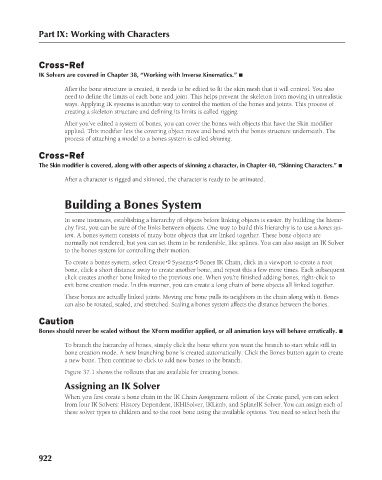Page 970 - Kitab3DsMax
P. 970
Part IX: Working with Characters
Cross-Ref
IK Solvers are covered in Chapter 38, “Working with Inverse Kinematics.” n
After the bone structure is created, it needs to be edited to fit the skin mesh that it will control. You also
need to define the limits of each bone and joint. This helps prevent the skeleton from moving in unrealistic
ways. Applying IK systems is another way to control the motion of the bones and joints. This process of
creating a skeleton structure and defining its limits is called rigging.
After you’ve edited a system of bones, you can cover the bones with objects that have the Skin modifier
applied. This modifier lets the covering object move and bend with the bones structure underneath. The
process of attaching a model to a bones system is called skinning.
Cross-Ref
The Skin modifier is covered, along with other aspects of skinning a character, in Chapter 40, “Skinning Characters.” n
After a character is rigged and skinned, the character is ready to be animated.
Building a Bones System
In some instances, establishing a hierarchy of objects before linking objects is easier. By building the hierar-
chy first, you can be sure of the links between objects. One way to build this hierarchy is to use a bones sys-
tem. A bones system consists of many bone objects that are linked together. These bone objects are
normally not rendered, but you can set them to be renderable, like splines. You can also assign an IK Solver
to the bones system for controlling their motion.
To create a bones system, select Create ➪ Systems ➪ Bones IK Chain, click in a viewport to create a root
bone, click a short distance away to create another bone, and repeat this a few more times. Each subsequent
click creates another bone linked to the previous one. When you’re finished adding bones, right-click to
exit bone creation mode. In this manner, you can create a long chain of bone objects all linked together.
These bones are actually linked joints. Moving one bone pulls its neighbors in the chain along with it. Bones
can also be rotated, scaled, and stretched. Scaling a bones system affects the distance between the bones.
Caution
Bones should never be scaled without the XForm modifier applied, or all animation keys will behave erratically. n
To branch the hierarchy of bones, simply click the bone where you want the branch to start while still in
bone creation mode. A new branching bone is created automatically. Click the Bones button again to create
a new bone. Then continue to click to add new bones to the branch.
Figure 37.1 shows the rollouts that are available for creating bones.
Assigning an IK Solver
When you first create a bone chain in the IK Chain Assignment rollout of the Create panel, you can select
from four IK Solvers: History Dependent, IKHISolver, IKLimb, and SplineIK Solver. You can assign each of
these solver types to children and to the root bone using the available options. You need to select both the
922

